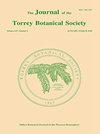Wood and bark anatomy of Salvadoraceae: ecology, relationships, histology of interxylary phloem1
IF 0.8
4区 生物学
Q4 PLANT SCIENCES
引用次数: 19
Abstract
CARLQUIST, S. (Santa Barbara Botanic Garden, 1212 Mission Canyon Road, Santa Barbara, CA 93105). Wood and bark anatomy of Salvadoraceae: relationships, ecology, histology of interxylary phloem. J. Torrey Bot. Soc. 129:10-20. 2002. Quantitative and qualitative data are presented for stem wood of one species each of Azima, Dobera, and Salvadora and for root wood of Salvadora. The liquid-preserved material of Salvadora permitted analysis of interxylary phloem: abaxial to most strands a "residual meristem" adds sieve-tube elements and companion cells to each strand, crushing earlier-formed phloem. Current opinion that Salvadoraceae are a sister family to Bataceae is supported by wood anatomy: they share such features as bands of mostly nonsubdivided axial parenchyma cells, wide multiseriate rays, and and storied structure. Nonbordered perforation plates, found also in other Capparales, are newly reported for Salvadoraceae. Koeberliniaceae have tracheids, Bataceae fibertracheids, thought more primitive than the libriform fibers of Salvadoraceae. Wood of Azima is moderately mesomorphic, perhaps because it grows near beaches where saline or brackish water is available to roots; Dobera and Salvadora have highly xeromorphic wood. The terms "foraminate included phloem" and "concentric included phloem" are misnomers and must be rejected.萨尔瓦多科木材和树皮解剖:生态学、关系、韧皮部组织学
卡尔奎斯特,S.(圣巴巴拉植物园,使命峡谷路1212号,圣巴巴拉,CA 93105)。萨尔瓦多科木材和树皮解剖:关系、生态学、韧皮部组织学。托里·博特。129:10-20 Soc。2002. 本文介绍了三种植物的茎材和根材的定量和定性数据。液体保存的Salvadora材料允许对木质部韧皮部进行分析:在大多数股的背面,一个“残余分生组织”为每条股添加了筛管元素和伴生细胞,粉碎了早期形成的韧皮部。目前认为Salvadoraceae是Bataceae的姐妹科的观点得到了木材解剖学的支持:它们具有这样的特征,即大多数不可细分的轴向薄壁细胞带,宽的多序列射线和多层结构。无边界穿孔板,也发现在其他卡帕拉属,是新报道的萨尔瓦多科。科有管胞,蝙蝠科有纤维管胞,被认为比萨尔瓦多科的libriform纤维更原始。阿齐玛的木材是中度中形的,也许是因为它生长在海滩附近,那里的咸水或微咸水对根是可用的;多贝拉和萨尔瓦多有高度旱胚性的木材。术语“有孔层含韧皮部”和“同心含韧皮部”是用词不当,必须予以拒绝。
本文章由计算机程序翻译,如有差异,请以英文原文为准。
求助全文
约1分钟内获得全文
求助全文
来源期刊
CiteScore
0.70
自引率
0.00%
发文量
16
审稿时长
>12 weeks
期刊介绍:
The Journal of the Torrey Botanical Society (until 1997 the Bulletin of the Torrey Botanical Club), the oldest botanical journal in the Americas, has as its primary goal the dissemination of scientific knowledge about plants (including thallopyhtes and fungi). It publishes basic research in all areas of plant biology, except horticulture, with an emphasis on research done in, and about plants of, the Western Hemisphere.

 求助内容:
求助内容: 应助结果提醒方式:
应助结果提醒方式:


